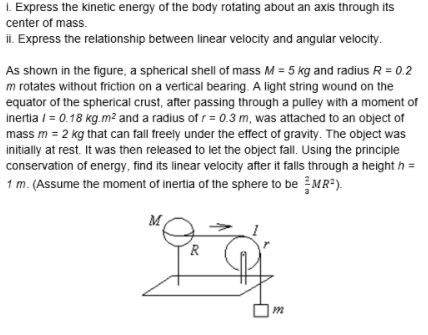1. Express the kinetic energy of the body rotating about an axis through its center of mass. II. Express the relationship between linear velocity and angular velocity. As shown in the figure, a spherical shell of mass M = 5 kg and radius R = 0.2 m rotates without friction on a vertical bearing. A light string wound on the equator of the spherical crust, after passing through a pulley with a moment of inertia / = 0.18 kg.m² and a radius of r = 0.3 m, was attached to an object of mass m = 2 kg that can fall freely under the effect of gravity. The object was initially at rest. It was then released to let the object fall. Using the principle conservation of energy, find its linear velocity after it falls through a height h = 1 m. (Assume the moment of inertia of the sphere to be MR³). M
1. Express the kinetic energy of the body rotating about an axis through its center of mass. II. Express the relationship between linear velocity and angular velocity. As shown in the figure, a spherical shell of mass M = 5 kg and radius R = 0.2 m rotates without friction on a vertical bearing. A light string wound on the equator of the spherical crust, after passing through a pulley with a moment of inertia / = 0.18 kg.m² and a radius of r = 0.3 m, was attached to an object of mass m = 2 kg that can fall freely under the effect of gravity. The object was initially at rest. It was then released to let the object fall. Using the principle conservation of energy, find its linear velocity after it falls through a height h = 1 m. (Assume the moment of inertia of the sphere to be MR³). M
Physics for Scientists and Engineers: Foundations and Connections
1st Edition
ISBN:9781133939146
Author:Katz, Debora M.
Publisher:Katz, Debora M.
Chapter12: Rotation I: Kinematics And Dynamics
Section: Chapter Questions
Problem 60PQ
Related questions
Question

Transcribed Image Text:I. Express the kinetic energy of the body rotating about an axis through its
center of mass.
il. Express the relationship between linear velocity and angular velocity.
As shown in the figure, a spherical shell of mass M = 5 kg and radius R = 0.2
m rotates without friction on a vertical bearing. A light string wound on the
equator of the spherical crust, after passing through a pulley with a moment of
inertia / = 0.18 kg.m² and a radius of r= 0.3 m, was attached to an object of
mass m = 2 kg that can fall freely under the effect of gravity. The object was
initially at rest. It was then released to let the object fall. Using the principle
conservation of energy, find its linear velocity after it falls through a height h =
1 m. (Assume the moment of inertia of the sphere to be MR-).
M
Expert Solution
This question has been solved!
Explore an expertly crafted, step-by-step solution for a thorough understanding of key concepts.
Step by step
Solved in 2 steps

Knowledge Booster
Learn more about
Need a deep-dive on the concept behind this application? Look no further. Learn more about this topic, physics and related others by exploring similar questions and additional content below.Recommended textbooks for you

Physics for Scientists and Engineers: Foundations…
Physics
ISBN:
9781133939146
Author:
Katz, Debora M.
Publisher:
Cengage Learning

College Physics
Physics
ISBN:
9781305952300
Author:
Raymond A. Serway, Chris Vuille
Publisher:
Cengage Learning

College Physics
Physics
ISBN:
9781938168000
Author:
Paul Peter Urone, Roger Hinrichs
Publisher:
OpenStax College

Physics for Scientists and Engineers: Foundations…
Physics
ISBN:
9781133939146
Author:
Katz, Debora M.
Publisher:
Cengage Learning

College Physics
Physics
ISBN:
9781305952300
Author:
Raymond A. Serway, Chris Vuille
Publisher:
Cengage Learning

College Physics
Physics
ISBN:
9781938168000
Author:
Paul Peter Urone, Roger Hinrichs
Publisher:
OpenStax College

University Physics Volume 1
Physics
ISBN:
9781938168277
Author:
William Moebs, Samuel J. Ling, Jeff Sanny
Publisher:
OpenStax - Rice University

College Physics
Physics
ISBN:
9781285737027
Author:
Raymond A. Serway, Chris Vuille
Publisher:
Cengage Learning

Glencoe Physics: Principles and Problems, Student…
Physics
ISBN:
9780078807213
Author:
Paul W. Zitzewitz
Publisher:
Glencoe/McGraw-Hill